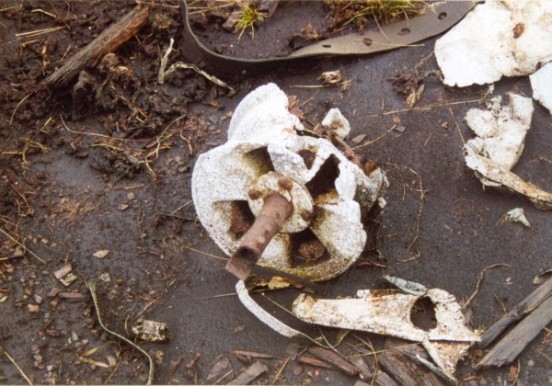Oxford Mk.I LX745 / B of No.11 (Pilot) Advanced Flying Unit, RAF crashed on Shining Tor on 12th March 1944 while on a navigation exercise from Calveley

| Charles Stuart Grant Wood | Flying Officer | Pilot (Inst) | Killed |
| Gerald Campbell Liggett | Flying Officer RCAF | Pilot (u/t) | Killed |
| Joseph George Hall | Flight Sergeant | Wireless Operator | Killed |
The aircraft was being used for a night cross country exercise from RAF Calveley near Nantwich. The briefed route was to have been Calveley – Wrexham – Lichfield – Calveley at a height of 2,300ft. They got airborne at 22:22hrs and headed on the initial short leg from just west of Nantwich to Wrexham, at this time the wind speed was increasing. The wireless operator obtained a QDR (bearing from the airfield) bearing from Calveley while in the Wrexham area at 22:34 and was heard by another aircraft at 23:15 trying to contact Calveley from the Lichfield area to obtain a QDM. These calls although heard by other aircraft were not received by the ground station and so went unanswered. Nothing further was heard of the crew or aircraft after this point.

It was five days later that the badly broken up wreck was discovered on the northern end of Shining Tor along with the bodies of the three crewmen who had all been killed instantly. The aircraft had been flying in a southerly direction and in a gentle turn to port when it struck the ground with its port wing before flying through wall which runs along the Cheshire / Derbyshire boundary. The aircraft then began to disintegrate and was scattered across the moor to around where parts still remain today. The wireless operators log was recovered from the wrecked aircraft and he had noted making calls with no times, but they were estimated to stop around 23:30 by using the log of the other aircraft which had heard calls as a guide.

The Court of Inquiry in the accident, held in the weeks after the crash, concluded that the position of the aircraft had been miscalculated while flying in zero visibility with fluctuating wind speeds, with a hour before taking off the wind being about 35 mph, decreasing to 15 mph at take off to around 50 mph at the time of the crash. It was thought that the drift caused by the weather was not compensated for as the gain in wind strength was unknown to the pilots. The crash occurred roughly at the time the aircraft would have been expected back at Calveley and so it was thought that the pilots had descended through the clouds on ETA over base. The failure to hear or answer any radio calls was put down the the ground station working with another aircraft at the time when these calls were made.
In addition to the findings of the Court it was noted that the Darky radio navigation aid was not used. It was recommended that crews should maintain regular contact with base with bearings being requested at regular intervals.


The three crew were all buried in Chester’s Blacon Cemetery, below are photographs of where they lie.
Sgt Hall is recorded as a navigator on his grave but in all the available documents relating to his service and crash he is recorded as a wireless operator.




